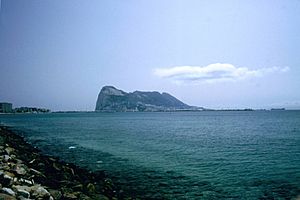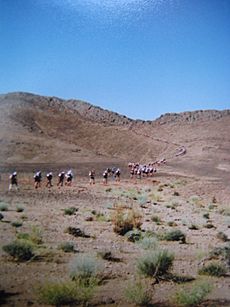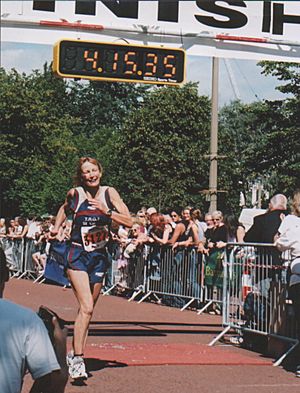Rosie Swale-Pope facts for kids
Quick facts for kids
Rosie Swale-Pope
|
|
|---|---|
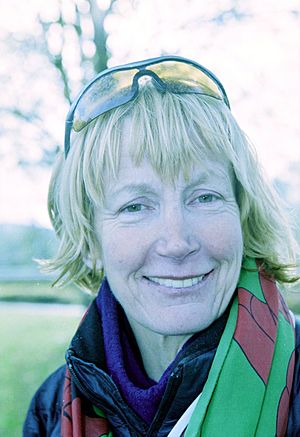
Swale-Pope in 2003
|
|
| Born |
Rosie Griffin
2 October 1946 Davos, Switzerland
|
| Nationality | British |
| Occupation | Writer, adventurer, marathon runner |
| Title | MBE |
| Children | Eve and James |
Rosie Swale-Pope, MBE (born October 2, 1946) is a British author, adventurer, and marathon runner. She is famous for her incredible five-year run around the world. During her run, she raised £250,000 for a charity supporting orphaned children in Russia. She also raised awareness about prostate cancer.
Her other amazing adventures include sailing alone across the Atlantic Ocean in a small boat. She also trekked 3,000 miles (4,800 km) through Chile by herself on horseback.
Contents
Early Life and Family
Rosie was born in Davos, Switzerland. Her Swiss mother had a serious lung illness called tuberculosis, and her Irish father was a major in the British Army. Because of this, she was raised by the wife of the local postman. When Rosie was two, her mother passed away. She then went to live with her grandmother in County Limerick, Ireland. Her grandmother had osteoarthritis, a painful joint disease that kept her in bed.
At age five, Rosie's father remarried. Even though her father's new family lived in the cottage next door, Rosie stayed with her grandmother. She took care of four orphaned donkeys, seven goats, and a pet cow. She loved exploring the countryside on her horse, Columbine.
Because her grandmother was worried about the local school, Rosie was taught at home. She mostly wrote about her daily adventures, which was great practice for her future career as a writer. After her father died in 1957, she was sent to a boarding school in Cork.
When she was 18, Rosie worked as a newspaper reporter. Soon after, she began her life of adventure by hitch-hiking to Delhi, Nepal, and Russia with very little money. In her early twenties, she married Colin Swale. They had a daughter, Eve, and bought a 30-foot (9 m) catamaran (a type of boat). They sailed to Italy, where their son, James, was born on the boat.
Sailing Adventures
Sailing Around the World
In December 1971, Rosie, her husband Colin, and their daughter Eve began a journey to sail around the world. They started from Gibraltar on their boat, the Anneliese. The trip was partly paid for by the Daily Mail newspaper and ITN news. ITN gave them a camera to film their journey.
They sailed 30,000 miles (48,300 km) across the Atlantic and Pacific Oceans. They stopped at amazing places like the Galapagos Islands and Tahiti. They even became the first crew to sail a catamaran around the dangerous Cape Horn.
The journey was risky. Rosie fell overboard once in the Caribbean, 900 miles (1,450 km) from land. Another time, the whole family got sick from food poisoning. Despite the dangers, they completed the trip. This was an amazing feat of sailing, as they only used a compass, charts, and a sextant to find their way before GPS was common.
Solo Atlantic Crossing
In 1983, Rosie sailed alone across the Atlantic Ocean in a small 17-foot (5.2 m) boat. She wanted to raise money for a hospital in London. She sailed from Wales on July 13, 1983. Using only the stars to navigate, she faced huge storms and almost ran out of food and water. After 70 days, she arrived safely in Staten Island, New York, after a journey of 4,800 miles (7,720 km).
Trekking Through Chile on Horseback
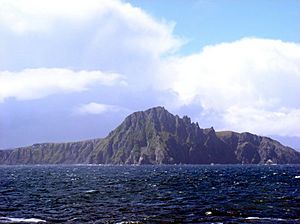
A year later, Rosie decided to travel 3,000 miles (4,830 km) through Chile on horseback. She rode two Chilean horses from the northern port of Antofagasta to Cape Horn. The journey was supposed to take four months but ended up taking fourteen.
She faced many challenges. Early in her trip, a sandstorm scattered her horses and gear. Later, she fell and broke two ribs. At one point, she got lost in the southern rainforests and nearly starved. She finally reached Cape Horn on September 2, 1985, after 409 days.
Incredible Runs and Marathons
Rosie is also a dedicated runner who has completed some of the world's toughest races.
The Sahara Desert Run
In 1997, Rosie ran 243 km (151 mi) across the Sahara desert in the Marathon des Sables. This race is known as "the toughest footrace on earth." Competitors run for six days and must carry all their supplies on their backs. Rosie completed this incredible race not once, but twice!
Other Challenging Runs
Rosie has run across many countries. She ran 1,000 miles (1,610 km) across Iceland in 1999. In 2000, she completed the famous Comrades Marathon in South Africa, a difficult 90 km (56 mi) ultramarathon. She also ran through dangerous areas in the Balkans and across Cuba. During her run in Cuba, she completed the Havana Marathon.
In 2002, she ran the Cardiff Marathon to raise money for the hospital where her husband Clive had passed away from prostate cancer.
Running Around the World
After her second husband, Clive, died in 2002, Rosie decided to take on her biggest challenge yet: running around the world. She wanted to raise money for the Prostate Cancer Charity and a Russian orphanage.
On her 57th birthday, October 2, 2003, she started from her hometown of Tenby, Wales. She had no support crew, only a small cart with her food and camping gear. She ran across Europe, Russia, and North America.
The journey was filled with incredible and dangerous moments.
- In Russia, Siberian wolves ran alongside her for a week.
- In Alaska, she survived temperatures of −60 °F (−51.1 °C) and got severe frostbite on her foot.
- She was hit by a bus near Lake Baikal and knocked unconscious.
- In Iceland, she slipped on ice, breaking several ribs and cracking her hip.
Despite all these hardships, Rosie never gave up. On August 25, 2008, after five years and 32,000 kilometres (19,900 mi), she returned home to Tenby. A large crowd gathered to celebrate her amazing achievement. She wrote a book about her journey called Just a Little Run Around the World.
Honours and Charity Work
For her amazing charity work, Rosie was made a MBE by Queen Elizabeth II.
She is a patron for PHASE Worldwide, a charity that helps poor communities in remote villages in Nepal. She ran across Nepal in 2003, raising over $8,000 for the charity and setting a new world record.
Published works
| Title | Publisher | Published | ISBN |
|---|---|---|---|
| Rosie Darling | Macmillan | 1973 | 978-0330240000 |
| Children of Cape Horn | HarperCollins | 1974 | 978-0236177134 |
| ... Don't Say No | Elek (Paul) (Scientific Books) Ltd | 1980 | 978-0583134651 |
| Back to Cape Horn | HarperCollins Publishers Ltd | 1986 | 978-0002174152 |
| Winter Wales | Golden Grove | 1989 | 978-1870876162 |
| Just a Little Run Around the World | HarperTrue | 2009 | 978-0007306206 |
See also
- List of pedestrian circumnavigators


